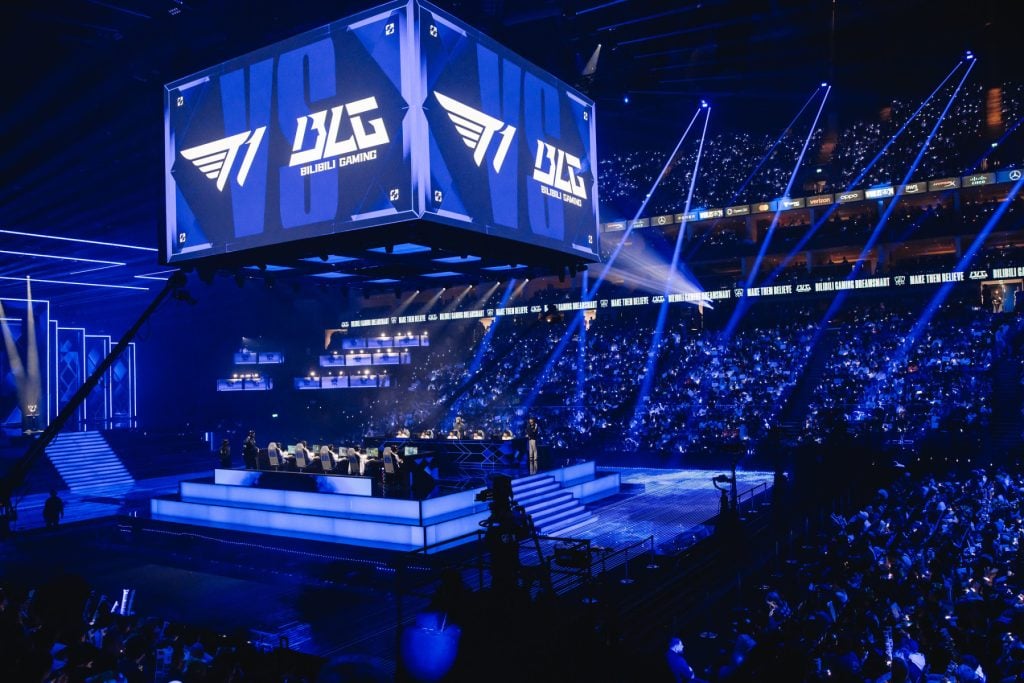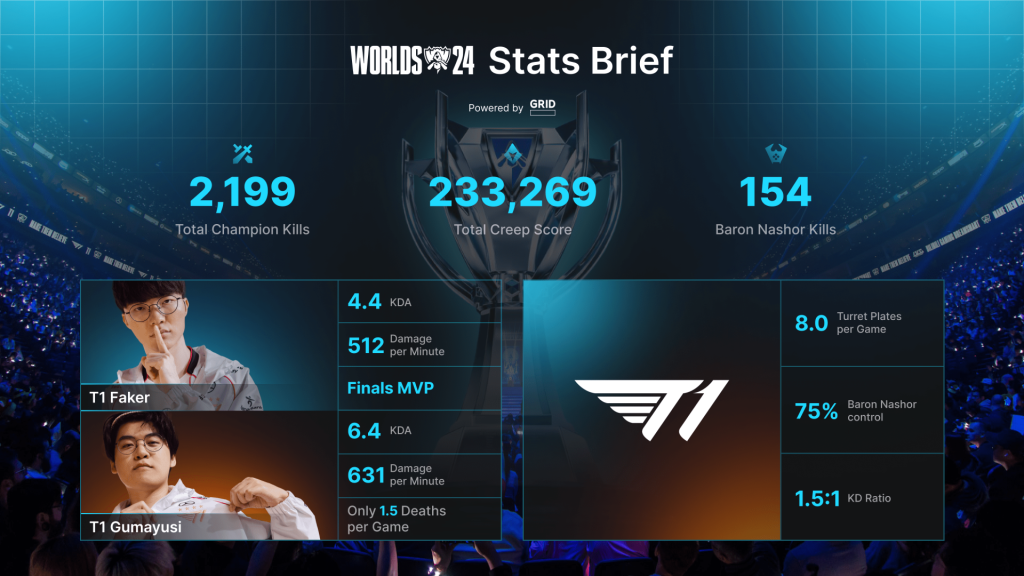
The League of Legends World Championship is arguably the most popular esports event in the world. Millions of spectators, ranging from hardcore esports enthusiasts to casual gamers, tune in to see some of the world’s best players and its often special Opening Ceremony.
However, League of Legends is a complex game. Players take into account a variety of factors and mechanics at once that can have huge ramifications to gameplay — visions, wave management, taking objectives at the right time and, of course, killing opponents.
To casual watchers these areas can be somewhat confusing, hence why it’s on the tournament organisers (in this case Riot Games) and broadcast talent to show statistics to guide audiences and create narratives in the matches. Using data is key to immersing the audience.
As a result, publishers and organisers have looked to bolster their efforts when it comes to utilising data. Riot Games, Ubisoft, KRAFTON, and BLAST have teamed up with game data platform GRID to use game data effectively to increase distribution opportunities and fan engagement projects.
To highlight the power and depth of esports data, GRID has provided Esports Insider with a range of stats and data points exclusively available on the GRID from the 2024 League of Legends World Championship.
Starting with the headlines, the 2024 League of Legends World Championship recorded 2,199 total champion kills, with 132 matches taking place in total. That means an average Worlds 2024 game featured 27.1 kills (across both competitors).
Thanks to the long-term relationship between GRID and Riot Games, these statistics can be compared across other League of Legends events. For example, this year’s League of Legends World Championship recorded slightly lower kills per game than non-Worlds tier one leagues in 2024 (LEC, LCK, LPL, LCS) — 27.1 compared to 28.6, respectively.
As mentioned prior, the amount of data that is available, when collected correctly, is immense. GRID even noted to Esports Insider that in total Worlds 2024 recorded a Creep Score (CS) of 233,269. CS is the number of minions and monsters that a champion has landed the killing blow on. The reason why this score is often heralded as important is because finishing off a minion or monster is a prime source of generating gold. . 154 Baron Nashors were also defeated throughout the world championship.
Detailed tournament statistics like these, at the very least, provide more opportunities for enthusiastic fans to consume esports content and create narratives. This can happen post-event or, given that data is sourced and distributed to the GRID’s partners in real-time, even during the competition.

It’s not just tournament statistics that are able to be garnered though. Individual team performance data can also be collected. Once again this can provide analytical insights on how a certain esports organisation, or player, has performed.
The eventual Worlds 2024 winner, Korean organisation T1, recorded an average of 13.5 kills per game with an impressive 1.5:1 kill-to-death ratio. In comparison, FlyQuest, the highest-placed Western representative, averaged one kill less (12.5) and a much lower kill-to-death ratio of 0.99:1.
Perhaps the biggest discrepancy between the world champions and the North American quarter-finalist came from statistics that are often not highlighted throughout typical broadcasts. GRID noted that around Baron Nasher, an in-game monster that typically provides a big advantage to teams when slain, T1 recorded a significantly higher percentage of control compared to FlyQuest’s matchups (75% Baron Nashor control compared to 58%).
Moreover, T1 on average destroyed 8 turret plates per game compared to FlyQuest’s 4.7. Turret plates are segments of the outer turret’s health that appear until the 14th minute. If a segment is destroyed by an opponent the players that do so gain an extra amount of gold.
GRID’s technology to analyse player performance is perhaps most crucial to League of Legends teams and organisations which can use the official League of Legends Data Portal for free, launched by GRID and Riot Games earlier this year. Teams and organisations participating in the official Riot Games events can access statistics that can be used by the organisation’s coaches to analyse team and individual performances and strategies for the next competition.
GRID showcased to Esports Insider two players in particular — T1’s ADC Gumayusi and star mid-laner Faker. At the end of the tournament, Faker had managed to achieve a 4.4 KDA (Kills/deaths/assists) and recorded 512 DPM (damage per minute).
Meanwhile, his teammate Gumayusi also excelled during the event recording a 6.4 KDA, 631 DPM and only 1.5 deaths per game. Overall the average KDA and DPM for Worlds 2024 was 3.6 and 448.9, respectively.
Ultimately the power of data is vast; not only can it bolster esports productions but it can help a variety of other industries. Extracting correct, live data reliably can help inform odds makers in the betting sector, while fan engagement platforms such as fantasy products or stats websites heavily rely on data metrics.
Whether it’s painting a simpler picture for casual watchers or offering in-depth analysis for League of Legends superfans, in-game data is the heartbeat of the game, helping to tell stories that go beyond the borders of the Rift.




